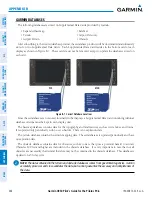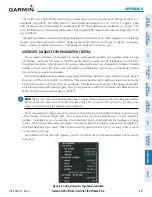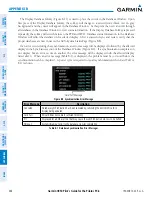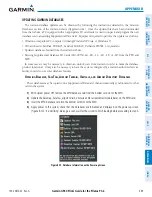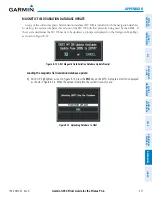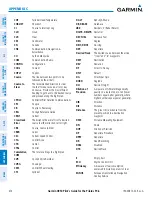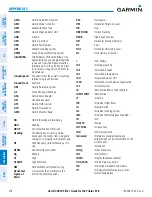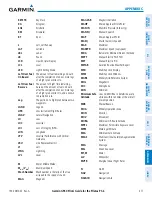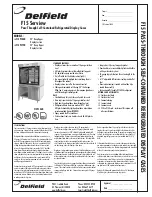
Garmin G950 Pilot’s Guide for the Pilatus PC-6
190-00870-02 Rev. A
SY
STEM
O
VER
VIEW
FLIGHT
INSTRUMENTS
EIS
AUDIO P
ANEL
& CNS
FLIGHT
MANA
GEMENT
HAZARD
AV
OID
ANCE
AFCS
ADDITIONAL FEA
TURES
APPENDICES
INDEX
480
APPENDIX C
V
MC
Minimum Control Speed
V
MO
(M
MO
)
Maximum Speed
V
NE
Never-Exceed Speed
V
R
Rotate Speed
V
X
Best Angle of Climb Speed
V
Y
Best Rate of Climb Speed
V
YSE
Best Single-Engine Rate of Climb Speed
V
Volts
V DEV
Vertical Deviation
VA
Heading Vector to Altitude Leg
VAC
Volts Alternating Current
VAPP
VOR Approach
VAR
Variation
VD
Heading Vector to DME Distance Leg
VDC
Volts Direct Current
VERT
Vertical
Vertical Figure
of Merit
A measure of the uncertainty in the
aircraft’s vertical position.
Vertical Speed
Required
The vertical speed necessary to descend/
climb from a current position and altitude
to a defined target position and altitude,
based upon current groundspeed.
VFOM
Vertical Figure of Merit
VFR
Visual Flight Rules
VHF
Very High Frequency
VI
Heading Vector to Intercept Leg
VLOC
VOR/Localizer Receiver
VM
Heading Vector to Manual Termination
Leg
VMC
Visual Meteorological Conditions
VNAV, VNV
Vertical Navigation
VOL
Volume
VOR
VHF Omnidirectional Range
VORTAC
VHF Omnidirectional Range Station and
Tactical Air Navigation
VPATH, VPTH
Vertical Path
VPL
Vertical Protection Level
VPROF
VNAV Profile, Vertical Profile
VR
Heading Vector to Radial Leg
VS
Vertical Speed
VSI
Vertical Speed Indicator
VSR, VS REQ
Vertical Speed Required
VTF
Vector to Final
W
Watt(s), West
WAAS
Wide Area Augmentation System
WARN
Warning
WATCH
Weather Attenuated Color Highlight
WGS-84
World Geodetic System - 1984
WPT
Waypoint(s)
WT
Weight
WW
World Wide
WX
Weather
XFER, XFR
Transfer
XM LTNG
SiriusXM Lightning
XPDR
Transponder
XTALK
Cross-Talk
XTK
Cross-Track
YD
Yaw Damper

